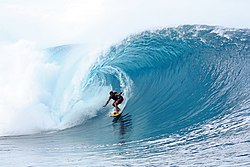
This glossary of surfing includes some of the extensive vocabulary used to describe various aspects of the sport of surfing as described in literature on the subject. [a] [b] In some cases terms have spread to a wider cultural use. These terms were originally coined by people who were directly involved in the sport of surfing.






